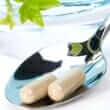Background
- Originally found in Peru, the use of cat's claw (Uncaria tomentosa) has been said to date back to the Inca civilization, possibly as far back as 2,000 years. It has been used for birth control, as an anti-inflammatory, as an immunostimulant, for cancer, and as an antiviral. The Peruvian Ashaninka priests considered cat's claw (Uncaria tomentosa) to have great powers and life-giving properties and therefore used it to ward off disease.
- Multiple plant species are marketed under the name cat's claw, the most common being Uncaria tomentosa and Uncaria guianensis. Both are used to treat the same indications, although supposedly the former may be a more efficacious immunostimulant.
- Cat's claw (Uncaria tomentosa) may be contaminated with other Uncaria species, including Uncaria rhynchophylla (used in Chinese herbal preparations under the name Gou-Teng), which purportedly may lower blood pressure, lower heart rate, or act as a neuroinhibitor. Reports exist of the potentially toxic Texan grown plant, Acacia gregii, being substituted for cat's claw in commercial preparations.
- In Germany and Austria, cat's claw is a registered pharmaceutical and can only be dispensed with a prescription. Currently, cat's claw is widely used and is one of the top herbal remedies sold in the United States despite a lack of high quality human evidence.
References
Natural Standard developed the above evidence-based information based on a thorough systematic review of the available scientific articles. For comprehensive information about alternative and complementary therapies on the professional level, go to . Selected references are listed below.
- Aguilar JL, Rojas P, Marcelo A, et al. Anti-inflammatory activity of two different extracts of Uncaria tomentosa (Rubiaceae). J Ethnopharmacol 2002;81(2):271-276.
View Abstract - Akesson C, Lindgren H, Pero RW, et al. An extract of Uncaria tomentosa inhibiting cell division and NF-kappa B activity without inducing cell death. Int Immunopharmacol 2003;3(13-14):1889-1900.
View Abstract - Allen-Hall L, Cano P, Arnason JT, et al. Treatment of THP-1 cells with Uncaria tomentosa extracts differentially regulates the expression if IL-1beta and TNF-alpha. J Ethnopharmacol 1-19-2007;109(2):312-317.
View Abstract - Ccahuana-Vasquez RA, Santos SS, Koga-Ito CY, et al. Antimicrobial activity of Uncaria tomentosa against oral human pathogens. Braz Oral Res 2007;21(1):46-50.
View Abstract - Cheng AC, Jian CB, Huang YT, et al. Induction of apoptosis by Uncaria tomentosa through reactive oxygen species production, cytochrome c release, and caspases activation in human leukemia cells. Food Chem Toxicol 2007;45(11):2206-2218.
View Abstract - Garcia Prado E, Garcia Gimenez MD, De la Puerta V, et al. Antiproliferative effects of mitraphylline, a pentacyclic oxindole alkaloid of Uncaria tomentosa on human glioma and neuroblastoma cell lines. Phytomedicine 2007;14(4):280-284.
View Abstract - Hardin SR. Cat's claw: an Amazonian vine decreases inflammation in osteoarthritis. Complement Ther Clin Pract 2007 Feb;13(1):25-8.
View Abstract - Kitajima M, Hashimoto K, Yokoya M, et al. Two new nor-triterpene glycosides from peruvian "Una de Gato" (Uncaria tomentosa). J Nat Prod 2003;66(2):320-323.
View Abstract - Lee J, Son D, Lee P, et al. Alkaloid fraction of Uncaria rhynchophylla protects against N-methyl-D-aspartate-induced apoptosis in rat hippocampal slices. Neurosci Lett 9-4-2003;348(1):51-55.
View Abstract - Lee J, Son D, Lee P, et al. Protective effect of methanol extract of Uncaria rhynchophylla against excitotoxicity induced by N-methyl-D-aspartate in rat hippocampus. J Pharmacol Sci 2003;92(1):70-73.
View Abstract - Moreno SR, Silva AL, Dire G, et al. Effect of oral ingestion of an extract of the herb Uncaria tomentosa on the biodistribution of sodium pertechnetate in rats. Braz J Med Biol Res 2007;40(1):77-80.
View Abstract - Mur E, Hartig F, Eibl G, et al. Randomized double blind trial of an extract from the pentacyclic alkaloid-chemotype of uncaria tomentosa for the treatment of rheumatoid arthritis. J Rheumatol 2002;29(4):678-681.
View Abstract - Piscoya J, Rodriguez Z, Bustamante SA, et al. Efficacy and safety of freeze-dried cat's claw in osteoarthritis of the knee: mechanisms of action of the species Uncaria guianensis. Inflamm Res 2001;50(9):442-448.
View Abstract - Setty AR, Sigal LH. Herbal medications commonly used in the practice of rheumatology: mechanisms of action, efficacy, and side effects. Semin Arthritis Rheum 2005;34(6):773-784.
View Abstract - Valerio LG Jr, Gonzales GF. Toxicological aspects of the South American herbs cat's claw (Uncaria tomentosa) and Maca (Lepidium meyenii): a critical synopsis. Toxicol Rev 2005;24(1):11-35.
View Abstract







